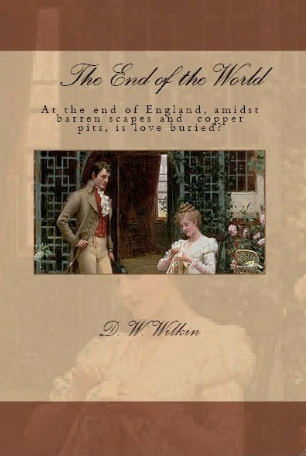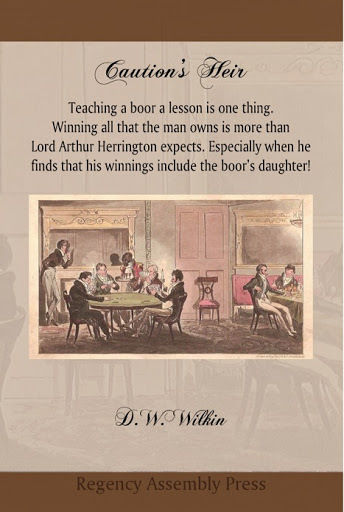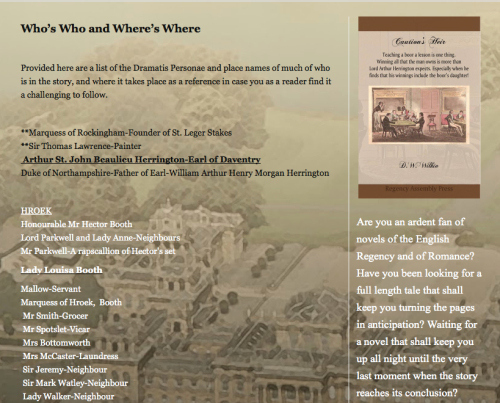D.W. Wilkin's Blog, page 185
September 3, 2014
Regency Personalities Series-Philip Hardwick
Regency Personalities Series
In my attempts to provide us with the details of the Regency, today I continue with one of the many period notables.
Philip Hardwick
15 June 1792 – 28 December 1870
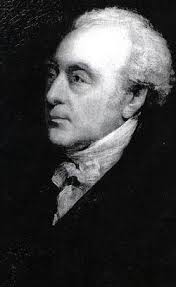
Philip Hardwick
Hardwick was born at 9 Rathbone Place (since demolished) in Westminster, London. He was educated at Dr Barrow’s school in Soho Square and trained as an architect under his father, Thomas Hardwick (junior), who was in turn the son of architect Thomas Hardwick Sr. The Hardwick family name spans over 150 years in the history of British architecture.
Philip Hardwick entered the Royal Academy Schools in 1808 and then studied in France and Italy from 1815 to 1819. After traveling Europe, he took over from his father as Surveyor to St Bartholomew’s Hospital, London. This post later passed on to Philip’s son – Philip Charles Hardwick, meaning that three successive generations of the family held the post.
In 1825 he was appointed architect to the St Katherine’s Dock Company, for whom he designed the dock buildings, Thomas Telford designing the docks themselves. In 1829 he became architect to the Goldsmiths’ Company, designing a new hall for them which was opened in 1835. In 1836 Hardwick became architect to the London and Birmingham Railway. He built a great Doric propylaeum, which became known as the “Euston Arch”, as an entrance to the railway’s Euston Station. In 1838 he built the Curzon Street Station as the railway’s Birmingham terminus. It is an austere cubic three-story building in the Ionic style, with a portico of four giant Ionic columns.
At Babraham Hall in 1822-3, on the site of a long-demolished sixteenth-century house, Hardwick adopted a Jacobean style, using red brick with limestone dressings. Brick was used again at Lincoln’s Inn, when, in 1843-5, Hardwick, in collaboration with his son, built a new hall and library. They used a Tudor style, the red brick varied with black brick decoration, and pale stone trim, foreshadowing the later fashion for polychrome brickwork. For churches, Hardwick used both the classical style, as at Christ Church, Cosway Street, Marylebone (1824-5), and the Gothic, as at Holy Trinity, Bolton (1823-5), St John’s, Catford (1854) and the Royal Garrison church, Aldershot (1863).
Hardwick gained a reputation as a surveyor and was employed by the Westminster Bridge estates, the Portman London estate, Greenwich Hospital, and the estate of the 2nd Marquess of Salisbury. He was also surveyor to Arthur Wellesley, 1st Duke of Wellington and assisted Sir Francis Smith in designing Wellington Barracks next to Buckingham Palace in 1833.
In 1831 his father in law, architect John Shaw Senior, helped elect Hardwick as a fellow of the Royal Society. Hardwick was a founding member of the Institute of British Architects (1834) – later (1837) the RIBA – and was a member of the Institution of Civil Engineers. In 1839 he was one of the judges for the new Royal Exchange building in the City of London, and was appointed to select the design for the Oxford Museum in 1854. He was elected an associate of the Royal Academy in1839, and became a Royal Academician in 1841
In 1854, he received the seventh Royal Gold Medal for architecture.
Philip married Julia Shaw in 1819, at St James’s Church, Piccadilly. Julia’s father, John Shaw Sr, and brother, John Shaw Jr, were both architects. The two families lived close by within the boroughs of Westminster and Holborn. Philip Hardwick had two sons, the eldest died of smallpox whilst still at Eton, the younger, Philip Charles Hardwick, was born in 1822 and trained as an architect under him. Philip Charles began working in the firm around 1843.
Hardwick was a close friend of the artist J. M. W. Turner, who had been a pupil of his father. In 1851 Turner chose Hardwick as an executor to his will.
Hardwick and much of his extended family were buried at Kensal Green Cemetery.
Hardwick’s best-known work is likely the 1837 ‘Propylaeum’ or Doric Euston Arch at the old Euston station, designed for the London and Birmingham Railway at the cost of £35,000. Like Inigo Jones some 200 years earlier, Hardwick had been inspired by Italian architecture, following a trip to Italy in 1818-19.


RAP has The End of the World
The End of the World This is the first of the Regency Romances I published. It is available for sale and I hope that you will take the opportunity to order your copy.
For yourself or as a gift. It is now available in a variety of formats. For $5.99 you can get this Regency Romance for your eReader. A little more as an actual physical book.
Barnes and Noble for your Nook
Amazon for your Kindle and as a Trade Paperback
Hermione Merwyn leads a pleasant, quiet life with her father, in the farthest corner of England. All is as it should be, though change is sure to come. For she and her sister have reached the age of marriage, but that can be no great adventure when life at home has already been so bountiful.
When Samuel Lynchhammer arrives in Cornwall, having journeyed the width of the country, he is down to his last few quid and needs to find work for his keep. Spurned by the most successful mine owner in the county, Gavin Tadcaster, Samuel finds work for Gavin’s adversary, Sir Lawrence Merwyn.
Can working for Sir Lawrence, the father of two young women on the cusp of their first season to far away London, be what Samuel needs to help him resolve the reasons for his running away from his obligations in the east of the country?
Will the daughters be able to find happiness in the desolate landscapes and deadly mines of their home? When a stranger arrives in Cornwall while the war rages on the Peninsula, is he the answer to one’s prayers, or a nightmare wearing the disguise of a gentleman?
Feedback
If you have any commentary, thoughts, ideas about the book (especially if you buy it, read it and like it ;-) then we would love to hear from you.


September 2, 2014
Regency Personalities Series-William Harrison Ainsworth
Regency Personalities Series
In my attempts to provide us with the details of the Regency, today I continue with one of the many period notables.
William Harrison Ainsworth
4 February 1805 – 3 January 1882
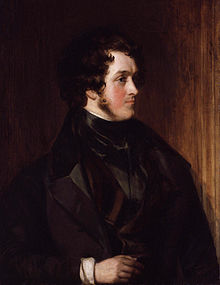
William Harrison Ainsworth
Ainsworth was born on 4 February 1805 to Thomas Ainsworth, a prominent Manchester lawyer, and Ann (Harrison) Ainsworth, the daughter of the Unitarian minister at Manchester Cross Street Chapel, the Rev. Ralph Harrison, in the family house at 21 King Street, Manchester. On 4 October 1806, Ainsworth’s brother, Thomas Gilbert Ainsworth, was born. Although the family home was eventually destroyed, it was a three-storey Georgian home in a well to do community. The area influenced Ainsworth with its historical and romantic atmosphere, which existed until the community was later replaced by commercial buildings. Besides the community, Ainsworth read romantic works as a child and enjoyed stories dealing with either adventure or supernatural themes. Of these, Dick Turpin was a favourite of Ainsworth. During his childhood, he adopted Jacobean ideas and held Tory ideas in addition to his Jacobite sympathies, even though his community was strict Whig and Nonconformist. During this time, Ainsworth began to write prolifically.
The Ainsworth family moved to Smedly Lane, north of Manchester in Cheetham Hill, during 1811. They kept the old residence in addition to the new, but resided in the new home most of the time. The surrounding hilly country was covered in woods, which allowed Ainsworth and his brother to act out various stories. When not playing, Ainsworth was tutored by his uncle, William Harrison. In March 1817, he was enrolled at the Manchester Grammar School, which was described in his novel Mervyn Clitheroe. The work emphasised that his classical education was of good quality but was reinforced with strict discipline and corporal punishment. Ainsworth was a strong student and was popular among his fellow students. Ainsworth’s school days were mixed; his time within the school and with his family was calm even though there were struggles within the Manchester community, the Peterloo Massacre taking place in 1819. Ainsworth was connected to the event because his uncles joined in protest at the incident, but Ainsworth was able to avoid most of the political after-effects. During the time, he was able to pursue his own literary interests and even created his own little theatre within the family home at King Street. He, along with his friends and brother, created and acted in many plays throughout 1820.
During 1820, Ainsworth began to publish many of his works under the name “Thomas Hall”. The first work, a play called The Rivals, was published on 5 March 1821 in Arliss’s Pocket Magazine. Throughout 1821, the magazine printed 17 other works of Ainsworth’s under the name “Thomas Hall”, “H A” or “W A”. The genre and forms of the work greatly varied, with one being a claim to have found plays of a 17th-century playwright “William Aynesworthe”, which ended up being his own works. This trick was later exposed. In December 1821, Ainsworth submitted his play Venice, or the Fall of the Foscaris to The Edinburgh Magazine. They printed large excerpts from the play before praising Ainsworth as a playwright as someone that rivalled even George Gordon Byron. During this time, Ainsworth was also contributing works to The European Magazine in addition to the other magazines, and they published many of his early stories. Eventually, he left the Manchester Grammar School in 1822 while constantly contributing to magazines.
After leaving school, Ainsworth began to study for law and worked under Alexander Kay. The two did not get along, and Ainsworth was accused of being lazy. Although Ainsworth did not want to pursue a legal career, his father pushed him into the field. Instead of working, Ainsworth spent his time reading literature at his home and various libraries, including the Chetham Library. He continued to work as an attorney in Manchester and spent his time when not working or reading at the John Shaw’s Club. By the end of 1822, Ainsworth was writing for The London Magazine, which allowed him to become close to Charles Lamb, to whom Ainsworth sent poetry for Lamb’s response. After receiving a favourable response for one set of works, Ainsworth had them published by John Arliss as Poems by Cheviot Ticheburn. He travelled some during 1822, and visited his childhood friend James Crossley in Edinburgh during August. While there, Crossley introduced Ainsworth to William Blackwood, the owner of Blackwood’s Magazine, and, through Blackwood, was introduced to many Scottish writers.
Besides Crossley, another close friend to Ainsworth was John Aston, a clerk who worked in his father’s legal firm. In 1823, Ainsworth and Crossley began to write many works together, including the first novel Sir John Chiverton. Ainsworth wrote to Thomas Campbell, editor of The New Monthly Magazine, about publishing the work: but Campbell lost the letter. At the request of Ainsworth, Crossley travelled to London to meet Campbell and discuss the matter before visiting in November. Although the novel was not yet published, in December 1823, Ainsworth was able to get G. and W. Whittaker to publish a collection of his stories as December Tales. During 1824, Ainsworth set about producing his own magazine, The Boeotian, which was first published on 20 March but ended after its sixth issue on 24 April.
Ainsworth’s father died on 20 June 1824 and Ainsworth became a senior in the law firm and began to focus on his legal studies. To this end he left for London at the end of 1824 to study under Jacob Phillips, a barrister at King’s Bench Walk. Ainsworth lived at Devereux Court, a place that was favoured by Augustine writers. During his stay, he visited Lamb, but felt let down by the real Lamb. Ainsworth attended Lamb’s circle, and met many individuals including Henry Crabb Robinson and Mary Shelley. During the summer of 1825, Ainsworth returned on a trip to Manchester in order to meet Crossley before travelling to the Isle of Man. He continued to write, and a collection of his poems called The Works of Cheviot Tichburn, with the types of John Leigh was published. He also had two works published in The Literary Souvenir, a magazine published by John Ebers.
On 4 February 1826, Ainsworth came of age and on 8 February was made a solicitor of the Court of King’s Bench. During this time, he befriended Ebers, who also owned the Opera House, Haymarket. Ainsworth would constantly visit shows at the house, and he fell in love with Ebers’s daughter Fanny during his visits. The relationship with the Ebers family continued, and John published a pamphlet of Ainsworth’s called Considerations on the best means of affording Immediate Relief to the Operative Classes in the Manufacturing Districts. The work, addressed to Robert Peel, discussed the economic situation in Manchester along with the rest of Britain. By June, Ainsworth left politics and focused on poetry with the publication of Letters from Cokney Lands. While these were printed he continued to work on his novel Sir John Chiverton and sought to have it published.
The novel was published by Ebers in July 1826. Ebers became interested in Ainsworth’s novel early on and started to add discussions about it in The Literary Souvenir in order to promote the work. Although the work was jointly written and sometimes claimed by Aston as solely his, many of the reviews described the novel as Ainsworth’s alone. The novel also brought Ainsworth to the attention of historical novelist Walter Scott, who later wrote about the work in various articles; the two later met in 1828. During that year, J. G. Lockhartt published Scott’s private journals and instigated the notion that the novel was an imitation of Scott. Sir John Chiverton is neither a true historical novel nor is it a gothic novel. It was also seen by Ainsworth as an incomplete work and he later ignored it when creating his bibliography. The novel does serve as a precursor to Ainsworth’s first major novel, Rookwood.
Ainsworth’s relationship with the Ebers family grew, and he married Fanny on 11 October 1826 with little warning to his family or friends. Ebers promised to pay a dowry of 300 pounds, but the funds were never given and this caused a strain in the relationship between Ainsworth and his father-in-law. Ainsworth continued in Ebers’s circle and attended many social events. He was encouraged by Ebers to sell his partnership in the Ainsworth law firm along with starting a publishing business. Ainsworth followed this advice, and the business had early success. In 1827, Fanny gave birth to a girl who took her name. Soon after, Ebers went bankrupt and Ainsworth lost a large sum as a consequence. Ainsworth published a few popular works, including The French Cook, the annual magazine Mayfair, and some others. By 1829, Ebers took over Ainsworth’s publishing business, and Fanny gave birth to another daughter, Emily, soon after. Ainsworth gave up on publishing and resumed working in law. When a third daughter, Anne, was born in 1830, Ainsworth’s family began to feel financially strained. Ainsworth returned to writing and he contributed to Fraser’s Magazine, but it is uncertain how many works were actually his. However, he was working on his novel Rookwood.
By 1829, Ainsworth was neither a lawyer nor a publisher; indeed he did not have any employment at all. He longed for his youthful days in Manchester and pondered writing another novel. By the summer, he had begun to travel. It was during this time that he began to develop the idea of Rookwood, and began searching for information on the subject. While researching for the novel in 1830, Ainsworth was living at Kensal Lodge. He worked on some theatrical pieces and spent the rest of his time working in the legal profession. He soon became friends with William Sergison, and the two travelled to Italy and Switzerland during that summer. During their travels, they visited the tomb of Percy Bysshe Shelley and John Keats, along with witnessing other notable scenes in the lives of the British Romantic poets. Sergison was also the owner of a residence in Sussex, upon which Ainsworth drew in his novel. After the two returned to London, Ainsworth began working for Fraser’s Magazine, which was launched in 1830. The group included many famous literary figures of the day, including Samuel Taylor Coleridge, Robert Southey, Thomas Carlyle, James Hogg and William Makepeace Thackeray. It was not until a visit to Chesterfield towards the end of 1831 that he was fully inspired to begin writing the novel.
Although he began writing the novel, Ainsworth suffered from more of his father-in-law’s financial problems and was unable to resume work on it until 1833. During the autumn of that year he managed to complete large portions of the novel while staying in Sussex, near Sergison’s home. The novel was published in April 1834 by Richard Bentley and contained illustrations by George Cruikshank. After working five years in the legal profession, Ainsworth gave it up and dedicated himself to writing. Rookwood garnered wide critical and financial success, and pleased his associates at Fraser’s Magazine. He started to dress as a dandy, and he was introduced to the Salon of Margaret Power, Countess of Blessington. Her Salon was a group of men and literary women, and would include many others but many in London believed that Blessington had a damaged reputation. However, this did not stop Ainsworth from meeting many famous British authors from the Salon. While part of her circle, he wrote for her collection of stories called The Book of Beauty, published in 1835. Ainsworth continued in various literary circles, but his wife and daughters did not; he stayed in Kensal Lodge while they lived with Ebers. During this time, Ainsworth met Charles Dickens and introduced the young writer to the publisher Macrone and to George Cruikshank. Ainsworth also introduced Dickens to John Forster at Kensal Lodge, initiating a close friendship between the two.
From 1835 until 1838, Ainsworth and Dickens were close friends and often travelled together. Rookwood was published in multiple editions, with a fourth edition in 1836 including illustrations by Cruikshank, which started the working relationship between the two. Ainsworth began writing another novel in 1835. Called Crichton, he devoted much of his time to it to the point of not having time for many of his literary friends. Its publication was temporarily delayed while Ainsworth was searching for an illustrator, with Thackeray being a possible choice. However, Ainsworth felt the illustrations were unsatisfactory, so he switched to Daniel Maclise, who was also later dropped. Coinciding with the search for an illustrator and hurrying to complete the novel, Ainsworth was asked to write for the magazine The Lions of London, but could not find the time to work on both projects and so attempted to finish the novel. The situation changed after Macrone, the original intended publisher, died. Ainsworth turned to Bentley as a publisher. Ainsworth eventually published his third novel in 1837. A fifth edition of Rookwood appeared in 1837, and its success encouraged Ainsworth to work on another novel about a famous outlaw, including the story of Jack Sheppard.
In 1839, Ainsworth was working on his next novel. Jack Sheppard was serially published in Bentley’s Miscellany from January 1839 until February 1840 while Charles Dickens’s Oliver Twist ran in the magazine. A controversy developed over the Newgate novels, and Dickens became distant from Ainsworth over the controversy. Soon after, Dickens retired from the magazine as its editor and made way for Ainsworth to replace him at the end of 1839. Jack Sheppard was published in a three volume edition by Bentley in October 1839, and 8 different theatrical versions of the story were staged in autumn 1839. Ainsworth followed Jack Sheppard with two novels: Guy Fawkes and The Tower of London. Both ran through 1840, and Ainsworth celebrated the conclusion of The Tower of London with a large dinner party to celebrate the works.
With the 1840 novels finished, Ainsworth began to write Old St. Paul’s, A Tale of the Plague and the Fire. The work ran in The Sunday Times from 3 January 1841 to 26 December 1841, which was an achievement as he became one of the first writers to have a work appear in a national paper in such a form. His next works, Windsor Castle and The Miser’s Daughter, appeared in 1842. The first mention of Windsor Castle comes in a letter to Crossley, 17 November 1841, in which Ainsworth admits to writing a novel about Windsor Castle and the events surrounding Henry VIII’s first and second marriages. The Miser’s Daughter was published first, starting with the creation of the Ainsworth’s Magazine, an independent project that Ainsworth started after leaving Bentley’s Miscellany. To create the magazine, Ainsworth joined up with Cruikshank who would serve as the illustrator. Cruikshank moved his efforts from his own magazine, The Omnibus to the new magazine, and an advertisement for it appeared in December 1841 saying that the first issue would be published on 29 January 1842. The opening of the magazine was welcomed by contemporary members of the press, which only increased as the magazine proved to be successful. Ainsworth’s Magazine marked the height of his career.
Ainsworth hoped to start publishing Windsor Castle in his magazine by April, but he was delayed when his mother died on 15 March 1842. John Forster wrote to Ainsworth to offer assistance in writing the novel, but there is no evidence that Ainsworth accepted. The work was soon finished and started appearing in the magazine by July 1842, where it ran until June 1843. George Cruikshank, illustrator for The Miser’s Daughter, took over as illustrator for Windsor Castle after the first one finished its run. A play version of The Miser’s Daughter, by Edward Stirling, appeared in October 1842, with another version by T. P. Taylor in November. During this time, Ainsworth had many well-known contributors to his magazine, including the wife of Robert Southey, Robert Bell, William Maginn in a posthumous publication, and others. By the end of 1843, Ainsworth sold his stake in the Ainsworth’s Magazine to John Mortimer while staying as the editor. The next work that Ainsworth included in his magazine was Saint James’s or the Court of Queen Anne, An Historical Romance, which ran from January 1844 until December 1844. The work was illustrated by George Cruikshank, which marks the last time that Ainsworth and Cruikshank collaborated on a novel.
In 1844, Ainsworth helped in the building of the monument to Walter Scott in Edinburgh. He spent his year visiting many people, including members of the British nobility. The popularity of his magazine decreased in the year due to a lack of quality works except for a series by Leigh Hunt, A Jar of Honey from Mount Hybla. Even Ainsworth’s own work, St James’s, was damaged because it was written in haste. During this time, Ainsworth began one of his best novels, Auriol, but it was never finished. It was published in part between 1844–1845 as Revelations of London. Hablot Browne, using the name “Phiz”, illustrated the work and became the main illustrator for the magazine. The novel was being produced until Ainsworth and Mortimer fought in early 1845, and Ainsworth resigned as editor. Soon after, Ainsworth bought The New Monthly Magazine and started asking contributors to the Ainsworth’s Magazine to join him at the new periodical. Ainsworth issued an advertisement saying that there would be contributors of “high rank”, which caused Thackeray to attack Ainsworth in Punch for favouring the nobility. However, Thackeray later contributed to the magazine along with others including Hunt, E V Keanley, G P R James, Horace Smith, and Edward Bulwer-Lytton. Ainsworth reprinted many of his own works in the magazine and his own portrait, the latter provoking a mock portrait of the back of Ainsworth’s head in Punch as the only angle that Ainsworth had not yet published for the public.
In 1845, two of Ainsworth’s friends and contributors died, Laman Blanchard and Richard Barham. Later in the year, Ainsworth was able to regain control over the Ainsworth’s Magazine and continued to republish many of his earlier works. He spent much of his time recruiting contributors to the two magazines, and published a new work in 1847, James the Second but claimed only to be the “editor” of the work. By 1847, he was able to purchase the copyright of many of his earlier works in order to reissue them. During this time, he was working on what would be his best novel, The Lancashire Witches. By the end of 1847, the plan of the novel was finished and the work was to be published in The Sunday Times.
In April 1872, a version of The Miser’s Daughter, called Hilda, was produced for the Adelphi Theatre by Andrew Halliday. On 6 April 1872, Cruikshank submitted a letter to The Times, claiming that he was upset about his name being left out of the credits for the play. Additionally, he claimed that the idea for the novel came from himself and not from Ainsworth. This provoked a controversy between the two.
His first success as a writer came with Rookwood in 1834, which features Dick Turpin as its leading character. In 1839 he published another novel featuring a highwayman, Jack Sheppard. From 1840 to 1842 he edited Bentley’s Miscellany, from 1842 to 1853, Ainsworth’s Magazine and subsequently The New Monthly Magazine.
His Lancashire novels cover altogether 400 years and include The Lancashire Witches, 1848, Mervyn Clitheroe, 1857, and The Leaguer of Lathom. Jack Sheppard, Guy Fawkes, 1841, Old St Paul’s, 1841, Windsor Castle, 1843, and The Lancashire Witches are regarded as his most successful novels. He was very popular in his lifetime and his novels sold in large numbers, but his reputation has not lasted well.


Space Opera Books Presents Trolling, Trolling, Trolling Fly Hides
Trolling, Trolling, Trolling Fly Hides!
Not only do I write Regency and Romance, but I also have delved into Fantasy.
The Trolling series, (the first three are in print) is the story of a man, Humphrey. We meet him as he has left youth and become a man with a man’s responsibilities.
We follow him in a series of stories that encompass the stages of life. We see him when he starts his family, when he has older sons and the father son dynamic is tested.
We see him when his children begin to marry and have children, and at the end of his life when those he has loved, and those who were his friends proceed him over the threshold into death. All this while he serves a kingdom troubled by monsters.
Troubles that he and his friends will learn to deal with and rectify.
It is now available in a variety of formats. For $2.99 you can get this fantasy adventure.
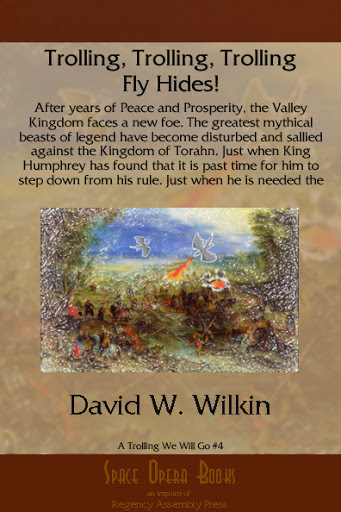
Barnes and Noble for your Nook
Old age is catching up to Humphrey and his friends. He feels it in his bones and with his son and heir having reached the prime of his life, it could very well be time to pass the baton of rule to Daniel.With the Valley Kingdom of Torahn at Peace, that would not be a terrible thing to do. Though breaking his decision to his wife Gwendolyn, the Queen, might be the hardest battle that he ever would fight.
Even as the life of retirement looks to be attractive and possible, however, the Valley Kingdom is beset again. Not Goblins, Trolls, Giants or Men, this time. No. That Humphrey knew would be far too easy.
Those obstacles had been overcome before and the problems they presented had solutions that the army of Torahn was trained to deal with. No, of all the creatures that came forth from Teantellen that they had beaten, the one they had never faced now came forth. Dragons!
Who in the realm knew how to fight these mythical beasts? Was there even away to do so?
Now Humphrey who had thought to spend the remainder of his days quietly writing his memoirs and drinking, was faced with the greatest challenge he had ever known.
Feedback
If you have any commentary, thoughts, ideas about the book (especially if you buy it, read it and like it ;-) then we would love to hear from you.


September 1, 2014
RAP is now looking for Cover and Interior artists-Can you draw like CE Brock?
Are you an Artist?
Now editing the final draft of another of our romance stories, we have started to lean to the idea that perhaps a professional artist might be better than our own renditions. Someone who can bring out the details and bring our stories alive.
If anyone knows of someone who would like to discuss designing a cover for RAP or the interiors (we think that a facing illustration at the start of every chapter like in the early part of the last century would be splendid), please get in contact with us.
In the immediate future we plan to launch a Kickstarter and wish to contract out the cover art and interior illustrations. Should we be funded in this project, you will be paid for your work immediately.
Our many works, one of the things we would like to see is having pen & ink or pencil illustrations at the beginning of each chapter. Can you draw like CE Brock? He did amazing work for the books and stories of Jane Austen in the early 1900s.
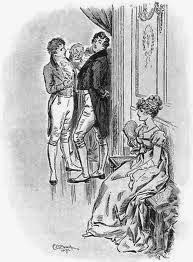
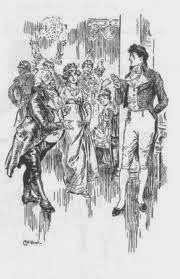


Caution’s Heir from Regency Assembly Press-Now available everywhere!
Caution’s Heir is now available at all our internet retailers and also in physical form as well
The Trade Paperback version is now available for purchase here @ $15.99 (but as of this writing, it looks like Amazon has still discounted it 10%)
Caution’s Heir is also available digitally for $4.99 @ the iBookstore, Amazon, Barnes and Noble, Kobo and Smashwords.
The image for the cover is a Cruikshank, A Game of Whist; Tom & Jerry among the ‘Swell Broad Coves.’ Tom and Jerry was a very popular series of stories at the time.
Teaching a boor a lesson is one thing.
Winning all that the man owns is more than Lord Arthur Herrington expects. Especially when he finds that his winnings include the boor’s daughter!
The Duke of Northampshire spent fortunes in his youth. The reality of which his son, Arthur the Earl of Daventry, learns all too well when sent off to school with nothing in his pocket. Learning to fill that pocket leads him on a road to frugality and his becoming a sober man of Town. A sober but very much respected member of the Ton.
Lady Louisa Booth did not have much hope for her father, known in the country for his profligate ways. Yet when the man inherited her gallant uncle’s title and wealth, she hoped he would reform. Alas, that was not to be the case.
When she learned everything was lost, including her beloved home, she made it her purpose to ensure that Lord Arthur was not indifferent to her plight. An unmarried young woman cast adrift in society without a protector. A role that Arthur never thought to be cast as. A role he had little idea if he could rise to such occasion. Yet would Louisa find Arthur to be that one true benefactor? Would Arthur make this obligation something more? Would a game of chance lead to love?
Today, the iBookstore is added, HERE
Get for your Kindle, Here
In Trade Paperback, Here
Digitally from Smashwords, Here
For your Sony Kobo, Here
Or for your Nook, Here
From our tale:
Chapter One
St. Oswald’s church was bleak, yet beautiful all in one breath. 13th century arches that soared a tad more than twenty feet above the nave provided a sense of grandeur, permanence and gravitas. These prevailed within, while the turret-topped tower without, once visible for miles around now vied with mature trees to gain the eye of passers-by.
On sunny days stain-glass windows, paid for by a Plantagenet Baron who lived four hundred years before and now only remembered because of this gift, cast charming rainbow beams across the inner sanctum. And on grey overcast days ghostly shadows danced along the aisle.
As per the custom of parish churches the first three pews were set-aside for the gentry. On this day the second pew, behind the seat reserved for the Marquess of Hroek, who hadn’t attended since the passing of his son and heir, was Louisa Booth his niece and her companion Mrs Bottomworth.
Mrs Bottomworth was a stocky matron on the good side of fifty. Barely on the good side of fifty. But one would not say that was an unfortunate thing for she wore her years well and kept her charge free of trouble. Mrs Bottomworth’s charge was an only child, who would still have been in the schoolroom excepting the fact of the death of her mother some years earlier. This had aged the girl quickly, and made her hostess to her father’s household. The Honourable Hector Booth, third son of the previous Marquess, maintained a modest house on his income of 300 pounds. That was quite a nice sum for just the man and one daughter, with but five servants. They lived in a small, two floor house with four rooms. It should be noted that this of course left two bedchambers that were not inhabited by family members. As the Honourable Mr Booth saved his excess pounds for certain small vices that confined themselves with drink and the occasional wager on a horse, these two rooms were seldom opened.
Mrs Bottomworth had thought to make use of one of the empty rooms when she took up her position, but the Honourable Hector Booth advised and instructed her to share his daughter’s room. For the last four years this is what she had done. When two such as these shared a room, it was natural that they would either become best of friends, or resent each other entirely. Happily the former occurred as Louisa was in need of a confidant to fill the void left in her mother’s absence, and Mrs Bottomworth had a similar void as her two daughters had grown and gone on to make their own lives.
The Honourable Mr Booth took little effort in concerning himself with such matters as he was ever about his brother’s house, or ensconced in a comfortable seat at either the local tavern or the Inn. If those locations had felt he was too warm for them, he would make a circuit of what friends and acquaintances he had in the county. The Honourable Mr Booth would spend an hour or two with a neighbour discussing dogs or hunters, neither of which he could afford to keep, though he did borrow a fine mount of his brother to ride to the hunt. The Marquess took little notice, having reduced his view of the world by degrees when first his beloved younger brother who was of an age between the surviving Honourable Mr Booth had perished shortly after the Marquess’ marriage. Their brother had fallen in the tropics of a fever. Then the Marquess had lost his second child, a little girl in her infancy, his wife but a few years after, and most recently his son and heir to the wars with Napoleon.
This caused the Honourable Mr Booth to be heir to Hroek, a situation that had occurred after he had lost his own wife. With that tragedy, Mr Booth had found more time to make friends with all sorts of new bottles, though not to a degree that it was considered remarkable beyond a polite word. Mr Booth was not a drunkard. He was confronting his grief with a sociability that was acceptable in the county.
Louisa, however, was cast further adrift. No father to turn to. No uncle who had been the patriarch of the family her entire life. And certainly now no feminine examples to follow but her companion and governess, Mrs Bottomworth. That Mrs Bottomworth was an excellent choice for the task was more due to acts of the Marquess, still able to think clearly at the time she was employed, than to the Honourable Mr Booth. Mr Booth was amenable to any suggestion of his elder brother for that man controlled his purse, and as Mr Booth was consumed with grief, while the Marquess had adapted to various causes of grief prior to the final straw of his heir’s death, the Marquess of Hroek clearly saw a solution to what was a problem.
Now in her pew, where once as a young girl she had been surrounded by her cousins, parents, uncles and aunt, she sat alone except for her best of friends. Louisa was full of life in her pew, her cheeks a shade of pink that contrasted with auburn hair, which glistened as sunlight that flowed though the coloured panes of glass touched it from beneath her bonnet. Blue eyes shown over a small straight nose, her teeth were straight, though two incisors were ever so slightly bigger than one would attribute to a gallery beauty painted by Sir Thomas Lawrence.
She was four inches taller than five feet, so rather tall for a young woman, but her genes bred true, and many a girl of the aristocracy was slightly taller than those women who were of humbler origins. Her back was straight and for an observant man, of which there were some few in the county, her figure might be discussed. The wrath though of her uncle the Marquess would not wish to be bourne should it be found out that her form had become a topic amongst the young men. Noteworthy though was that she had a figure that men thought inspiring enough to tempt that wrath, and think on it. A full bosom was high on her chest, below her heart shaped face. She was lean of form, though her hips flared just enough that one could see definition in her torso. Certainly a beauty Sir Thomas’ brushes would wish the honour to meet.
The vicar Mr Spotslet had at one time in his early days in the community, discussed the Sunday sermons with the Marquess. Mr Spotslet had enjoyed long discussions of theology, philosophy, natural history and the holy writ that were then thoughtfully couched in terms to be made accessible by the parish. The lassitude that had overtaken the Marquess had caused those interviews to become shortened and infrequent and as such the sermons suffered, as many were wont to note. There had been dialogues that Mr Spotslet had engaged in with the attendees of his masses. Now he seemed to have lost his way and delivered soliloquies.
This day Mr Spotslet indulged in a speech that talked to the vices of gambling. The local sports, of which the Honourable Mr Booth was an intimate, had raced their best through the village green the previous Wednesday for but a prize of one quid, and this small bet had caused pandemonium when Mrs McCaster had fallen in the street with her washing spread everywhere and trampled by the horses. Not much further along the path, Mr Smith the grocer’s delivery for the vicar himself was dropped by the boy and turned into detritus as that too was stampeded over. A natural choice for a sermon, yet only two of the culprits were in attendance this day. The rest had managed to find reasons to avoid the Mass.
Louisa squirmed a little in her seat the moment she realised that her father had been one of the men that the sermon was speaking of. Was she not the centre of everyone’s gaze at such a time? Her father having refused to attend for some years, and her uncle unable due to his illness. She was the representative of the much reduced family. Not only was it expected that the parish would look to her as the Booth of Hroek, but with her father’s actions called to the attentions of all, it was natural that they look at her again. This time in a light that did not reflect well on her father and she knew that she had no control over that at all.
Mrs Bottomworth, who might have been lightly resting her eyes, Louisa would credit her in such a generous way, came to tensing at the mention of the incident. Louisa did not want to bring her friend to full wakefulness, but Mrs Bottomworth realised what was occurring and the direction that the sermon was taking. Louisa’s companion took her hand and patted it reassuringly.
“Perhaps a social call on Lady Walker?” Mrs Bottomworth suggested as they walked back to the house after services. The house which sat just within the estate boundaries was four hundred feet off the main bridal way that led to Hroek Castle. A small road had been cleared from the gatehouse to the house that Mr Booth now maintained, and this the two women travelled.
Louisa generally appreciated visits such as this as she had gotten older, and certainly several of the adults in the neighbourhood showed a kindly interest in her education and the development of her social manners. “I think I shall go to the castle and read to my uncle.” A task that she had done each day of the last fortnight but one.
“We have not talked, but you and the Marquess had an interview with the doctors.” Mrs Bottomworth had tried to comfort her charge after that, but Louisa had waved her hand and gone to sit quietly under a yew tree that had a grand vista of the park leading to Hroek Castle.
“Uncle will be most lucky if he should be with us come Michaelmas.”
“That will be a sad day when we lose such a friend.” These were words of comfort. Mrs Bottomworth had been well encouraged in her charge by the Marquess but one could not say that they interacted greatly with one another. The Marquess ensured that his brother heeded the suggestions and advisements of Mrs Bottomworth as the Honourable Mr Booth left to his own devices would have kept his daughter in the nursery and would have forgotten to send a governess to provide her with instruction.
“Indeed, my uncle may not have been one of the great men of England, but he is well regarded in the county.” Often with that statement followed the next, “Warmly remembered is it when the Prince Regent came and stayed for a fortnight of sport and entertainment.” This had been many years before, and certainly before any of the tragedies beset the line of the Booths.
“Yes, I have heard it said with great earnestness. But come let us change your clothes and then we shall go up to the great house. I shall have Mallow fetch the gig so we may proceed all the more expeditiously.”
“That would be good, but we will have to use the dogcart. Father was to take the gig to see Sir Mark today, or so he said at breakfast.” Where Louisa knew he would drink the Baronet’s sherry for a couple hours before thinking to return, unless he was asked to stay for dinner.


Regency Personalities Series-John Hudson
Regency Personalities Series
In my attempts to provide us with the details of the Regency, today I continue with one of the many period notables.
John Hudson
1773 – 31 October 1843
John Hudson was the son of John Hudson, a farmer at Haverbrack in the parish of Beetham. He attended Heversham School and entered Trinity College, Cambridge in 1793. He became senior wrangler in 1797, also winning the Smith’s prize in that year, and obtained his MA in 1800.
He became a Fellow, in 1798, and tutor, in 1807, of Trinity College, Cambridge, where he notably tutored George Peacock: he also tutored John Martin Frederick Wright. In 1815, he became the vicar of Kendal, Westmoreland. In 1815, he married the daughter of an army officer by the name of Culliford.
At Cambridge, Hudson also tutored Charles James Blomfield who became a prominent bishop. As a bishop, Blomfield visited Hudson’s parish and at a dinner party declared “I remember well, Mr. Hudson, how much I stood in awe of you at College.” To which Hudson retorted, “Perhaps so, but your Lordship has turned the tables on me now.”
Hudson died at Haverbrack, Tuesday, October 31, 1843 at the age of 71 and was buried in the interior of the parish church at Kendal.


Space Opera Books presents ECO Agents:Save The Planet a Young Adult Adventure
First ECO Agents book available
Those who follow me for a long time know that I also write in other fields aside from Regency Romance and the historical novels I do.
A few months ago, before the end of last year and after 2011 NaNoWriMo, (where I wrote the first draft of another Regency) I started work on a project with my younger brother Douglas (All three of my brothers are younger brothers.)
The premise, as he is now an educator but once was a full on scientist at the NHI and FBI (Very cloak and dagger chemistry.) was that with the world having become green, and more green aware every week, why not have a group of prodigies, studying at a higher learning educational facility tackle the ills that have now begun to beset the world.
So it is now released. We are trickling it out to the major online channels and through Amazon it will be available in trade paperback. Available at Amazon for your Kindle, or your Kindle apps and other online bookstores. For $5.99 you can get this collaboration between the brothers Wilkin. Or get it for every teenager you know who has access to a Kindle or other eReader.
Barnes and Noble for your Nook Smashwords iBookstore for your Apple iDevices Amazon for your Kindle
Five young people are all that stands between a better world and corporate destruction. Parker, Priya, JCubed, Guillermo and Jennifer are not just your average high school students. They are ECOAgents, trusted the world over with protecting the planet.
Our Earth is in trouble. Humanity has damaged our home. Billionaire scientist turned educator, Dr. Daniel Phillips-Lee, is using his vast resources to reverse this situation. Zedadiah Carter, leader of the Earth’s most powerful company, is only getting richer, harvesting resources, with the aid of not so trustworthy employees.
When the company threatens part of the world’s water supply, covering up their involvement is business as usual. The Ecological Conservation Organization’s Academy of Higher Learning and Scientific Achievement, or simply the ECO Academy, high in the hills of Malibu, California overlooking the Pacific Ocean, is the envy of educational institutions worldwide.
The teenage students of the ECO Academy, among the best and brightest the planet has to offer, have decided they cannot just watch the world self-destruct. They will meet this challenge head on as they begin to heal the planet.
Feedback
If you have any commentary, thoughts, ideas about the book (especially if you buy it, read it and like it ;-) then we would love to hear from you.


August 31, 2014
Caution’s Heir has a Who’s Who and Where’s Where site for reference help!
 Originally posted on The Things That Catch My Eye:
Originally posted on The Things That Catch My Eye:
After a request from one reader and then a review by another who clearly was amongst the minority of reviewers who do not understand my style, for Caution’s Heir, I have added a page at the Caution’s HeirWebsite This has a list of who is who and where things take place in the novel.
Please have a look (you can click on the picture to get to the site):


Regency Personalities Series-Charles Vane 3rd Marquess of Londonderry
Regency Personalities Series
In my attempts to provide us with the details of the Regency, today I continue with one of the many period notables.
Charles Vane 3rd Marquess of Londonderry
18 May 1778 – 6 March 1854
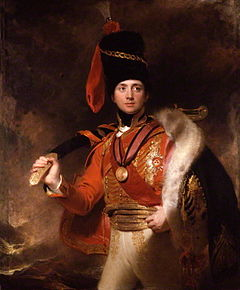
Charles Vane
Born in Dublin, Charles Stewart (as he then was), was the only son of Robert Stewart, 1st Marquess of Londonderry, by his second wife Lady Frances, daughter of Charles Pratt, 1st Earl Camden. Robert Stewart, Viscount Castlereagh, was his half-brother. Charles Stewart was educated at Eton, and at the age of 16 was commissioned into the British Army as a Lieutenant. He saw service in Flanders in 1794, and was Lieutenant Colonel of the 5th Royal Irish Dragoons by the time he helped put down the Irish Rebellion of 1798. Two years later he was elected to the Irish House of Commons as Tory representative for Thomastown, County Kilkenny, and after only two months exchanged this seat for that of Londonderry County. He sat for the latter constituency until the Act of Union in 1801, and represented then Londonderry in the British House of Commons until 1814.
In 1803 Stewart was appointed aide-de-camp to King George III, and four years later became Under-Secretary of State for War and the Colonies. During the Corunna Campaign of 1808–1809 he commanded a brigade of cavalry, and played a prominent role in the cavalry clash of Benavente. In April 1809 he was made Adjutant General to Sir Arthur Wellesley (later the Duke of Wellington) with the British forces fighting in the Peninsular War, a post in which he distinguished himself, particularly at the battles of Busaco and Talavera. He received the thanks of Parliament in 1810, and on 20 November 1813 was made Colonel of the 25th Light Dragoons, becoming a Knight of the Bath that same year. Until the end of the war he was Envoy Extraordinary and Minister Plenipotentiary to Berlin, and was also Military Commissioner with the allied armies, being wounded at the Battle of Kulm.
The recipient of numerous foreign honours, Stewart was also, in 1814, ennobled as Baron Stewart, of Stewart’s Court and Ballylawn in the County of Donegal. That same year he received honorary degrees from Oxford and Cambridge, was admitted to the Privy Council, and was appointed a Lord of the Bedchamber to the King. He was also made Ambassador to Vienna, a post he held for nine years, and was at the Congress of Vienna with his half brother Lord Castlereagh as one of the British plenipotentiaries, where, he made a spectacle of himself with his loutish behaviour, being apparently rather often inebriated, frequenting prostitutes quite openly, touching up young women in public, and once even starting a fist fight in the middle of the street with a Viennese coach driver (from whom he had to be rescued by the Austrian constabulary).
He was appointed Knight Grand Cross of the Royal Guelphic Order in 1816 and made colonel of the 10th (The Prince of Wales’s Own) Regiment of (Light) Dragoons (Hussars) on 3 February 1820.
His first wife was Lady Catherine Bligh, daughter of the 3rd Earl of Darnley, whom he married in 1804; she was three years older than he. She died during the night of 10–11 February 1812, of fever following a minor operation, while her husband was on active service in the Peninsula.
After he married his second wife Lady Frances Anne Vane-Tempest, daughter and heiress of Sir Henry Vane-Tempest, on 3 April 1819, Lord Londonderry took the surname of Vane, by royal licence, and used his new bride’s immense wealth to acquire the Seaham Hall estate in County Durham with a view to developing the coal fields there. He also built the harbour at Seaham, to rival nearby Sunderland.
The family also used their new-found wealth to redecorate their main country seat in Ireland, Mount Stewart, and bought Holderness House on London’s Park Lane, which they renamed Londonderry House.
Charles Stewart succeeded his half-brother as 3rd Marquess of Londonderry in 1822. The following year he was created Earl Vane and Viscount Seaham, of Seaham in the County Palatine of Durham, with remainder to the heirs male of the body of his second wife.
Governor of County Londonderry from 1823, Londonderry was appointed Lord Lieutenant of Durham in 1842 and the following year became Colonel of the 2nd Regiment of Life Guards. He was finally made a Knight of the Garter in 1853, and died a year later at Londonderry House. Scrabo Tower in Newtownards, County Down was erected in his memory.
He was succeeded as 4th Marquess of Londonderry by his son from his first marriage, and as 2nd Earl Vane by his son from his second marriage.
Frederick William Robert Stewart, 4th Marquess of Londonderry
George Henry Robert Charles William Vane-Tempest, 5th Marquess of Londonderry
Lady Frances Anne Emily Vane; married John Spencer-Churchill, 7th Duke of Marlborough.
Lady Alexandrina Octavia Maria Vane; married Henry Dawson-Damer, 3rd Earl of Portarlington.
Lord Adolphus Frederick Charles William Vane-Tempest; became insane
Lady Adelaide Emelina Caroline Vane; married, Rev. Frederick Henry Law.
Lord Ernest McDonnell Vane-Tempest
Through his daughter Lady Frances, Lord Londonderry was the great-grandfather of Winston Churchill.



